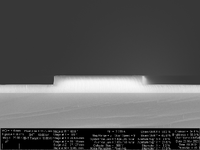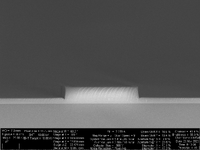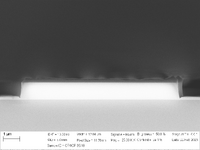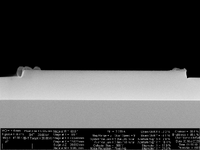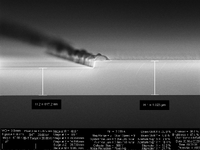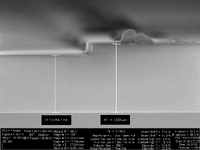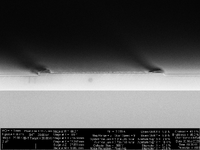Specific Process Knowledge/Etch/Etching of Silicon Oxide/SiO2 etch using ASE/CF4 recipes for SiO2
Unless otherwise stated, all content in this section was done by Maria Farinha@DTU Nanolab, April 2023
Due to the instability of older SiO2 etch recipes, 1SIOICP1 and TSIO2_02, new recipes are being developed, with a CF4/H2 chemistry. Two new recipes were created, to replace the older ones, CF4ICP and CF4lowCP. The first one aims for thicker etches, with higher ER, while the other is a slower etch, dedicated to thinner layers.
| Parameter | Recipe name: CF4ICP | Recipe name: CF4lowCP |
|---|---|---|
| Coil Power [W] | ||
| Platen Power [W] | ||
| Platen temperature [oC] | ||
| CF4 flow [sccm] | ||
| H2 flow [sccm] | ||
| Pressure [mTorr] |
- CF4 and H2 flow values were changed in order to find the best recipe regarding selectivity between SiO2 and the resist and also the uniformity.
Results with pat Si wafer, 1um of SiO2 and AZ5214E resist - April 2023
The gas flows were combined and the following results were achieved. It´s visible that with higher CF4 the selectivity is not good, so by adding H2, until 1:1, the selectivity improves. Additionally, the uniformity gets slightly worse while going for 1:1 of gas chemistry.
The recipe CF4lowCP 22.5/22.5 seems to be the only one good enough to use. It is a slow etch recipe, with good selectivity with AZ5214E resist.
| CF4ICP | 45 CF4 + 0 H2 | 35 CF4 + 10 H2 | 22.5 CF4 + 22.5 H2 |
|---|---|---|---|
| SiO2 ER (nm/min) | |||
| Uniformity (SiO2 etch) | |||
| Selectivity (SiO2:resist) |
- The uniformity considers a 100mm wafer, calculated with 5 points.
| CF4lowCP | 45 CF4 + 0 H2 | 35 CF4 + 10 H2 | 22.5 CF4 + 22.5 H2 |
|---|---|---|---|
| SiO2 ER (nm/min) | |||
| Uniformity (SiO2 etch) | |||
| Selectivity (SiO2:resist) |
Profile pictures of some tests - April 2023 @mfarin
Even in the cases with the resist strip (plasma asher 2 processing for 10/15min), there are some traces of resist left on the edges of the features.
Also, it´s noticeable that the feature profile is trenching, being more evident with faster etch rates.
Further tests will be done, testing these recipes' etch rates regarding silicon and silicon nitride, since most of the time these are the adjacent layers.

